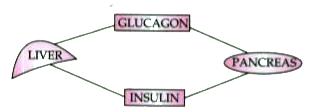Cells producing moulting hormones are
Trophocytes
Hoemocytes
Oenocytes
Mycetocytes.
To solve the question regarding which cells produce moulting hormones in arthropods, let's analyze the options provided step by step:
1. Understanding Moulting Hormones:
- Moulting hormones, also known as ecdysteroids, are crucial for the process of moulting (ecdysis) in arthropods. This process involves shedding the old exoskeleton to allow for growth.
2. Identifying the Options:
- The options given are:
- A) Tropocyte
- B) Hemocyte
- C) Oncyocyte
- D) Mycetocyte
3. Evaluating Each Option:
- Tropocyte: These are fat body cells in cockroaches that store glycogen and lipids. They are not primarily responsible for producing moulting hormones.
- Hemocyte: These are the blood cells in insects. They play various roles, including immune responses and potentially producing hormones.
- Oncyocyte: Similar to tropocytes, these are also fat body cells and do not produce moulting hormones.
- Mycetocyte: These cells are associated with symbiotic relationships in some insects and are not involved in hormone production.
4. Conclusion:
- After evaluating the options, the correct answer is B) Hemocyte, as these cells can produce moulting hormones.
Final Answer:
The cells producing moulting hormones are Hemocytes.
- Moulting hormones, also known as ecdysteroids, are crucial for the process of moulting (ecdysis) in arthropods. This process involves shedding the old exoskeleton to allow for growth.
- The options given are:
- A) Tropocyte
- B) Hemocyte
- C) Oncyocyte
- D) Mycetocyte
- Tropocyte: These are fat body cells in cockroaches that store glycogen and lipids. They are not primarily responsible for producing moulting hormones.
- Hemocyte: These are the blood cells in insects. They play various roles, including immune responses and potentially producing hormones.
- Oncyocyte: Similar to tropocytes, these are also fat body cells and do not produce moulting hormones.
- Mycetocyte: These cells are associated with symbiotic relationships in some insects and are not involved in hormone production.
- After evaluating the options, the correct answer is B) Hemocyte, as these cells can produce moulting hormones.
The cells producing moulting hormones are Hemocytes.
Topper's Solved these Questions
- PHYLUM - ARTHROPODABOOK - DINESH PUBLICATION ENGLISHCHAPTER - PHYLUM - ARTHROPODAEXERCISE - CYG
20 Videos
- PHYLUM - ANNELIDABOOK - DINESH PUBLICATION ENGLISHCHAPTER - PHYLUM - ANNELIDAEXERCISE - Check your grasp
10 Videos
- PLANT BREEDING AND DISEASE CONTROLBOOK - DINESH PUBLICATION ENGLISHCHAPTER - PLANT BREEDING AND DISEASE CONTROLEXERCISE - Check your Grasp
10 Videos
Similar Questions
Knowledge Check
Leydig cells produce a group of hormones called
AandrogensBestrogensCaldosteroneDgonadotropins.TSH (thyroid stimulating hormone) is produced by
Aadrenal cortexBmiddle pituitary lobeCanetrior pituitary lobeDposterior pituitary lobe.
Group of neurosecretory cells which produces hormones and are located in hypothalamus are known as
View SolutionIn animal cells, lipid like steroid hormones are synthesized by which cell organelle?
View SolutionEcdysone/moulting hormone is produced by
View SolutionHormones FSH/LH called as Gonadotropins hormones are produced by
View SolutionStudy the diagram given below and then answer the questions that follow :

What is the technical term for the cells of the pancreas that produce endocrine hormones ?
View SolutionMaturation of T-Cells promoted by the hormone
View Solution
